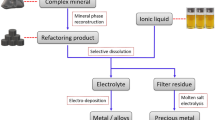Abstract
Blast furnace slag is produced in large quantities as a by-product in the steel manufacturing process. In this study, a method for synthesizing lead ion adsorbent with high adsorption ability was investigated by alkali activation of the blast furnace slag. A sodium hydroxide aqueous solution was used as an alkali activator, and silica was added to the aqueous solution to improve the adsorption capacity. Alkali activation of the blast furnace slag with the sodium hydroxide aqueous solution yielded lead ion adsorbent. Addition of silica to the sodium hydroxide aqueous solution further increased the lead ion adsorption capacity. Langmuir adsorption isotherms revealed that the highest maximum adsorption capacity of 1658.1 mg-Pb/g was obtained when 5 g of silica was added to 50 mL of the sodium hydroxide aqueous solution. The adsorption capacity for lead ion decreased when more than 10 g of silica was added to the sodium hydroxide aqueous solution.






Similar content being viewed by others
REFERENCES
Nippon Slag Assoc., The Annual Report of Statistics of Iron and Steel Slag 2021, Tokyo: Nippon Slag Assoc., 2022.
Abdel-Ghani, N.T., Elsayed, H.A., and Abdel Moide, S., Geopolymer synthesis by the alkali-activation of blast furnace steel slag and its fire-resistance, HBRC J., 2018, vol. 14, pp. 159–164.
Amer, I., Kohai, M., El-Feky, M.S., Rashad, A., and Khalaf, M.A., A review on alkali-activated slag concrete, Ain Shams Eng. J., 2021, vol. 12, pp. 1475–1499.
Davidovits, J., Geopolymers inorganic polymer new materials, J. Therm. Anal. Calorim., 1991, vol. 37, pp. 1633–1656.
Khale, D. and Chaudhary, R., Mechanism of geopolymerization and factors influencing its development: A review, J. Mater. Sci., 2007, vol. 42, pp. 729–746.
Marín-López, C., Rubio-Avalos, J.C., Manzano-Ramírez, A., Avalos, J.C.R., Perez-Bueno, J.J., Muniz-Villareal, M.S., Ventura-Ramos, E., and Vorobiev, Y., Synthesis and characterization of a concrete based on metakaolin geopolymer, Inorg. Mater., 2009, vol. 45, pp. 1528–1531.
Khater, H.M., Effect of silica fume on the characterization of the geopolymer materials, Int. J. Adv. Struct. Eng., 2013, vol. 5, p. 12.
Okoye, F.N., Durgaprasad, J., and Singh, N.B., Effect of silica fume on the mechanical properties of fly ash based-geopolymer concrete, Ceram. Int., 2016, vol. 42, pp. 3000–3006.
Cheng, T.W., Lee, M.L., Ko, M.S., Ueng, T.H., and Yang, S.F., The heavy metal adsorption characteristics on metakaolin-based geopolymer, Appl. Clay Sci., 2012, vol. 56, pp. 90–96.
Al-Harahsheh, M.S., Zboon, K.A., Al-Makahadmeh, L., Hararh, M., and Mahasneh, M., Fly ash based geopolymer for heavy metal removal: A case study on copper removal, J. Env. Chem. Eng., 2015, vol. 3, pp. 1669–1677.
Tan, T.H., Mo, K.H., Ling, T.-C., and Lai, S.H., Current development of geopolymer as alternative adsorbent for heavy metal removal, Env. Technol. Innov., 2020, vol. 18, p. 100684.
Bernal, S.A., Rodríguez, E.D., Mejía de Gutiérre, R., and Provis, J.G., Performance at high temperature of alkali-activated slag pastes produced with silica fume and rice husk ash based activators, Mater. Constr., 2015, vol. 65, p. e049.
Tashima, M.M., Reig, L., Santini, M.A., Jr., Moraes, J.C.B., Akasaki, J.L., Paya, J., Borrachero, M.V., and Soriano, L., Compressive strength and microstructure of alkali-activated blast furnace slag/sewage sludge ash (GGBS/SSA) blends cured at room temperature, Waste Biomass Valor., 2017, vol. 8, pp. 1441–1451.
Lancellotti, I., Catauro, M., Ponzoni, C., Bollino, F., and Leonelli, C., Inorganic polymers from alkali activation of metakaolin: Effect of setting and curing on structure, J. Solid State Chem., 2013, vol. 200, pp. 341–348.
Monneron-Gyurits, M., Joussein, E., Soubrand, M., Fondanèche, P., and Rossignol, S., Valorization of mussel and oyster shells toward metakaolin-based alkaline activated material, Appl. Clay Sci., 2018, vol. 162, pp. 15–26.
Funding
This work was supported by ongoing institutional funding. No additional grants to carry out or direct this particular research were obtained.
Author information
Authors and Affiliations
Corresponding author
Ethics declarations
The authors of this work declare that they have no conflicts of interest.
Additional information
Publisher’s Note.
Pleiades Publishing remains neutral with regard to jurisdictional claims in published maps and institutional affiliations.
Rights and permissions
About this article
Cite this article
Uchida, Y., Iwaki, T. & Hongo, T. Effect of Silica Addition on Lead Ion Adsorption Ability of Alkali-Activated Blast Furnace Slag. Glass Phys Chem 49, 651–656 (2023). https://doi.org/10.1134/S1087659623600035
Received:
Revised:
Accepted:
Published:
Issue Date:
DOI: https://doi.org/10.1134/S1087659623600035




